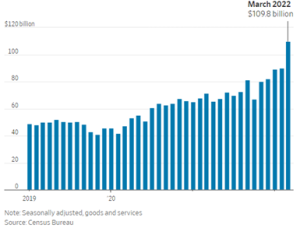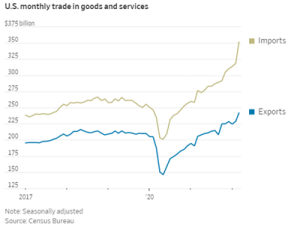In March, inflation, supply imbalances, and strong demand for imported goods widened the U.S. trade deficit, with clothing, computers, and vehicles driving the surge.
Therefore, according to the Commerce Department, the trade gap in goods and services widened by 22.3% in March from the prior month to a seasonally adjusted $109.8 billion. Before the Covid-19 pandemic, the trade deficit had hovered between $40 billion and $50 billion a month.

Imports rose by 10.3% to $351.5 billion as the U.S. took in far more goods than it exported. In March, the gridlock at U.S. ports eased, alleviating supply-chain congestion that has disrupted trade during the pandemic and freeing up more goods for store shelves. Exports also rose a robust 5.6% in March on higher shipments of industrial supplies and as more travelers came to the U.S. for vacation.
However, the pandemic-related turmoil remains a trade issue. Economists expect China’s tight lockdown related to the increase in COVID-19 patients and the Ukrainian war could disrupt the global. Economy and supply chain in the coming months. It could hurt demand for U.S. exports. At the same time, a strong dollar is ready to help boost the desire for imports.

Global trade has been volatile, with companies struggling with shipping backlogs, product scarcity, order cancellations, and delays. Thus, the trade imbalance weighed on U.S. gross domestic product in the first quarter as businesses and consumers faced high inflation, a shortage of available workers, and rising borrowing costs. Imports of industrial supplies, consumer goods, and vehicles rose sharply in March, likely reflecting price increases contributing to the high U.S. inflation rate.





